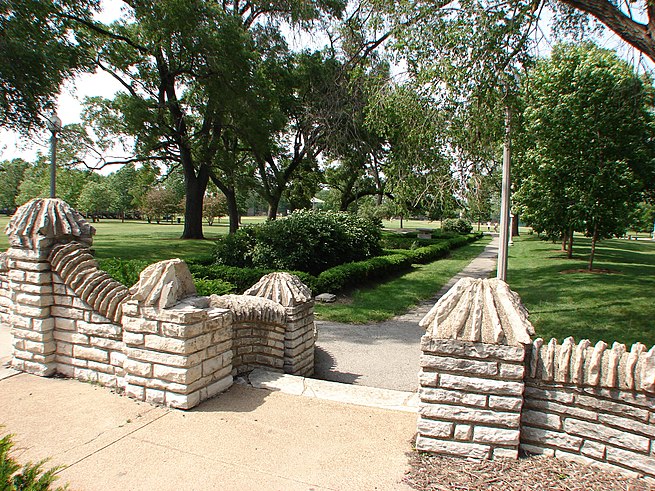
Main Difference
The main difference between Flagstone and Bluestone is that the Flagstone is a building material and Bluestone is a cultural or commercial name for a number of dimension or building stone varieties.
-
Flagstone
Flagstone (flag) is a generic flat stone, cutting regular rectangular or square in shape and usually used for paving slabs or walkways, patios, flooring, fences and roofing. It may be used for memorials, headstones, facades and other construction. The name derives from Middle English flagge meaning turf, perhaps from Old Norse flaga meaning slab or chip.
Flagstone is a sedimentary rock that is split into layers along bedding planes. Flagstone is usually a form of a sandstone composed of feldspar and quartz and is arenaceous in grain size (0.16 mm – 2 mm in diameter). The material that binds flagstone is usually composed of silica, calcite, or iron oxide. The rock color usually comes from these cementing materials. Typical flagstone colors are red, blue, and buff, though exotic colors exist.
Flagstone is quarried in places with bedded sedimentary rocks with fissile bedding planes.
Around the thirteenth century, the ceilings, walls and floors in European architecture became more ornate. Anglo-Saxons in particular used flagstones as flooring materials in the interior rooms of castles and other structures.Lindisfarne Castle in England and Muchalls Castle (14th century) in Scotland are among many examples of buildings with surviving flagstone floors.
Flagstone shingles are a traditional roofing material, a type of roof shingle commonly used in the Alps, where they are laid dry, often held in place with pegs or hooks. In the Aosta Valley, Italy, stone shingles are mandatory to cover buildings in historical areas.
-
Bluestone
Bluestone is a cultural or commercial name for a number of dimension or building stone varieties, including:
basalt in Victoria, Australia, and in New Zealand
dolerites in Tasmania, Australia; and in Britain (including Stonehenge)
feldspathic sandstone in the U.S. and Canada
limestone in the Shenandoah Valley in the U.S., from the Hainaut quarries in Soignies, Belgium, and from quarries in County Carlow, County Galway and County Kilkenny in Ireland
slate in South Australia
-
Flagstone (noun)
A flat, rectangular piece of rock or stone used for paving or roofing.
-
Flagstone (noun)
One of several types of rock easily split and suitable for making flagstones.
-
Bluestone (noun)
A form of dolerite which appears blue when wet or freshly broken.
-
Bluestone (noun)
Any of several massive Stonehenge.
-
Bluestone (noun)
A feldspathic sandstone in the U.S.
-
Bluestone (noun)
A form of limestone native to the Shenandoah Valley
-
Bluestone (noun)
A basalt or olivine basalt.
-
Bluestone (noun)
Slate from quarries in or near Adelaide.
-
Flagstone (noun)
a flat stone slab, typically rectangular or square, used for paving
“a flagstone terrace”
“there was a carpet on the flagstones of the hall”
-
Bluestone (noun)
any of various bluish or grey building stones.
-
Bluestone (noun)
any of the smaller stones made of dolerite found in the inner part of Stonehenge.
